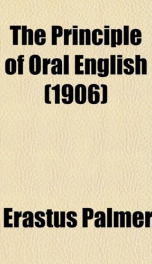the principle of oral english

Purchase of this book includes free trial access to www.million-books.com where you can read more than a million books for free. This is an OCR edition with typos. Excerpt from book: CHAPTER III MODULATION Modulation is any variation of tone; and tone, in the application of the term to the subject under discussion in this book, is the sound of the human voice used in speaking or reading. Tone has four recognized properties. They are: Quality, Force, Pitch and Rate. Any variation in any of these properties, such as change from one kind of quality of tone to another, or from one degree of force, pitch or rate to another degree of the same property, is modulation. Quality is that property of the human voice by which expression is given to a thought, an emotion, a feeling, or a sentiment by the kind of tone used in speaking. Force is the energy with which words are uttered. Pitch is the elevation or depression of the voice in the gamut. Rate is the speed at which words are uttered. The basic principle of vocal expression is Quality, because it, above all other properties, is the most easily affected by sentiment or emotion. It cannot be used, however, except in conjunction with one or more of the other properties of the human voice,Force, Rate or Pitch, and so at least two of the four properties occur in the expression of a thought, a feeling, an emotion, or a sentiment. Any change in Quality, Force, Pitch or Rate, when it occurs involuntarily, is the vocal expression of a mental condition; when it is produced voluntarily it is the effort of the speaker to reproduce the vocal evidence of the mental condition which originally gave rise naturally to the particular modification thus reproduced. The various kinds of Quality are called Normal, or Pure, Tone, Orotund, Guttural and Whisper. Normal Quality, sometimes called Pure Tone, is the customary sound of one's voice as it is used in stating a fact which is not associated with emotio...
Users who have this book
Users who want this book
What readers are saying
What do you think? Write your own comment on this book!
write a commentif you like the principle of oral english try:
Other books by this author
Do you want to exchange books? It’s EASY!
Get registered and find other users who want to give their favourite books to good hands!


